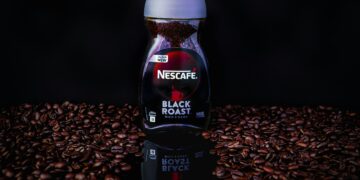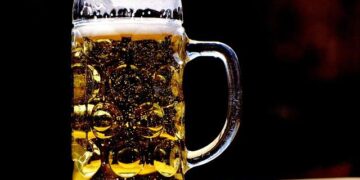Table of Contents
As a health researcher, I’ve spent my career dissecting data and scrutinizing clinical trials.
I thought I understood the human body and the substances we put into it.
I was wrong.
My wake-up call came not in a lab, but under the fluorescent lights of a 24-hour convenience store.
I was on a crushing deadline for a grant proposal, the kind of intellectual marathon that demands more than your brain is willing to give.
Desperate, I grabbed a brightly colored can—one of the high-octane brands promising “potent brain & body-rocking fuel.” I glanced at the label, saw the promise of focus, and ignored the fine print.
What followed wasn’t focus.
It was a terrifying, full-body mutiny.
Within an hour, my heart was hammering against my ribs, a frantic, irregular rhythm that felt utterly alien.1
A cold sweat broke O.T. My thoughts, instead of coalescing into a brilliant proposal, splintered into a million anxious fragments.
I was having a full-blown panic attack, fueled by a 16-ounce can.
The subsequent crash was even worse, leaving me physically drained and mentally hollow.
That experience was humbling.
It was also infuriating.
How could I, a professional in the health field, have been so naive? The standard advice—”just watch the caffeine”—was clearly, dangerously inadequate.
This personal failure ignited a professional mission: to apply my research skills to the booming, multi-billion dollar energy drink market and understand what was really inside those cans.
I needed to move beyond the marketing hype and build a new framework for understanding these complex beverages.
The Caffeine Illusion & The “Energy Cocktail” Epiphany
The core problem with how we approach energy drinks is that we’ve been trained to ask the wrong question.
We walk up to the cooler and ask, “How much caffeine does it have?” This one-dimensional view is precisely what the industry, now valued at over $63 billion globally, has leveraged to its advantage.3
It simplifies a complex product into a single, marketable number.
My epiphany came when I stopped thinking of an energy drink as a simple beverage and started seeing it for what it truly is: a complex and often unpredictable cocktail.
The caffeine content is just the base spirit, like the vodka in a mixed drink.
But as any bartender knows, the other ingredients—the mixers, the syrups, the bitters, the garnishes—fundamentally change the experience, the effect, and the aftermath.
Here is the “Energy Cocktail” framework that changed everything for me:
- The Base Spirit (Caffeine): This is the primary stimulant. Its potency, measured in milligrams (mg), is the foundation of the drink’s effect.
- The Syrups & Sweeteners (Sugar, Sucralose): These dictate the initial taste, the caloric load, and, crucially, the potential for a “sugar crash.” A drink with 54 grams of sugar is a different beast entirely from its zero-sugar counterpart.4
- The Herbal “Bitters” (Guarana, Ginseng): These are potent plant extracts that modify the effects of the base spirit. They add complexity and, in the case of guarana, can introduce a “hidden” caffeine load that isn’t always obvious on the label.5
- The Mixers & Garnishes (Taurine, B-Vitamins): These ingredients are often highlighted for their supposed benefits, but their actual contribution to the “energy” effect is debatable and frequently serves more as a marketing garnish than a functional component.7
Judging an energy drink by its caffeine content alone is like trying to understand a Long Island Iced Tea by only measuring its alcohol proof.
You’re missing the five other ingredients that make it notoriously potent and unpredictable.
This “Energy Cocktail” model is the key to truly understanding what you’re consuming and why a 200 mg drink from one brand can feel so radically different from a 200 mg drink from another.
Deconstructing the Cocktail: An Expert’s Guide to What You’re Really Drinking
To make informed choices, we must understand each component of the cocktail.
This means looking past the flashy marketing and examining the science behind the ingredients list.
The Base Spirit: Understanding Caffeine
Caffeine is a powerful central nervous system stimulant.
It works primarily by blocking adenosine receptors in the brain.
Adenosine is a neurotransmitter that promotes relaxation and sleepiness; by inhibiting it, caffeine increases alertness and reduces fatigue.5
While effective, there is a clear limit to safe consumption.
Leading health authorities like the U.S. Food and Drug Administration (FDA), the Mayo Clinic, and Health Canada have established guidelines based on extensive research.
Exceeding these limits can lead to the very symptoms I experienced: nervousness, insomnia, irritability, and abnormal heart rhythms.10
Table 1: Official Daily Caffeine Limits
| Population Group | Recommended Max Daily Caffeine (mg) | Source(s) |
| Healthy Adults | 400 mg | 11 |
| Pregnant or Breastfeeding Women | 300 mg | 14 |
| Adolescents (13-18 years) | 2.5 mg per kg of body weight | 13 |
| Children (10-12 years) | 85 mg | 15 |
| Children (7-9 years) | 62.5 mg | 15 |
| Children (4-6 years) | 45 mg | 15 |
Note: Health Canada’s recommendation for adolescents is a precautionary approach due to limited data; heavier adolescents may be able to tolerate adult doses.15
The American Academy of Pediatrics recommends against caffeine consumption for all children and adolescents.19
The Hidden Stimulant: Guarana
The first “bitter” in our cocktail is guarana, a plant from the Amazon basin whose seeds contain a higher concentration of caffeine than coffee beans—up to 8% by weight.20
This is where the simple caffeine number on the front of the can becomes misleading.
The addition of guarana creates a potential “hidden caffeine load.” While regulations require manufacturers to list caffeine and guarana as ingredients, the way they are categorized can be confusing.
Energy drinks are often marketed as dietary supplements, a category with different labeling rules than conventional foods.22
A manufacturer might list “Caffeine: 200 mg” prominently on the label, but then include guarana in a proprietary “energy blend.” Since about 1 gram of guarana extract can contain 40 mg of caffeine, the total stimulant effect can be significantly higher than what the consumer believes they are drinking.19
This regulatory loophole is a critical reason why some drinks feel much more potent than their numbers suggest and can lead to unexpected side effects like severe anxiety or heart palpitations.9
The Syrups & Sweeteners: Sugar, Crashes, and Calories
Sugar is the main ingredient after water in many classic energy drinks, with some 12-ounce cans containing as much as 39 grams or more—rivaling or exceeding traditional sodas.4
A standard 16-ounce can of Monster Energy, for example, contains a staggering 54 grams of sugar.24
This high sugar load is linked to weight gain and an increased risk of type 2 diabetes and cardiovascular disease.4
Physiologically, this sugar delivers a rapid energy spike, but it’s inevitably followed by the dreaded “crash.” This occurs when the initial surge in blood glucose prompts a massive release of insulin, which then causes blood sugar levels to plummet, leading to fatigue, lethargy, and irritability.1
The rise of zero-sugar alternatives, using sweeteners like sucralose, is a direct response to this problem.27
Consumers choose them to avoid calories and the sugar crash.
However, this presents a different kind of trade-off.
By removing the buffering effect of a rapid sugar high, the stimulant effect of the caffeine can feel more “raw” and direct.
For some individuals, this doesn’t feel “cleaner”; it feels sharper, leading to more pronounced jitteriness and anxiety.
The choice is not simply between a “healthy” and “unhealthy” option, but between two different cocktail profiles: one that risks a sugar-induced crash, and one that risks a more jarring, potentially anxiety-inducing stimulant effect.
The Mysterious Mixers: Taurine, Ginseng, and B-Vitamins
These are the ingredients that often add a veneer of scientific legitimacy or healthfulness to the can, but their roles are complex and often overstated.
- Taurine: This amino acid is naturally present in the human body and is essential for various metabolic functions.28 Contrary to urban legend, the taurine in energy drinks is synthetic and plant-based, not derived from bulls.29 While some studies suggest it may improve mental performance when combined with caffeine, its role is controversial.30 In fact, taurine can also act as an inhibitory neurotransmitter, binding to GABA receptors in a way that could have a sedative-like effect.28 The Mayo Clinic concludes that its safety within the complex mixture of an energy drink is unclear.8 This makes taurine an unpredictable variable in the cocktail, with some research even suggesting it can exacerbate the cardiac effects of caffeine when consumed together.31
- Ginseng: A traditional herbal root, ginseng is often marketed as a brain booster.6 However, there is little robust scientific evidence to support claims of improved energy or memory from the minimal amounts found in energy drinks.32 Furthermore, ginseng can have side effects, including hypertension and insomnia, and can interact with medications.33
- B-Vitamins: This is perhaps the most brilliant piece of marketing in the industry. Brands like Red Bull and Monster prominently feature B-vitamins like Niacin (B3), B6, and B12, often in enormous percentages of the recommended daily value—sometimes exceeding 20,000%.34 This creates a “health halo,” making the consumer feel like they are drinking a vitamin supplement. The reality is that B-vitamins do not
provide energy; they are coenzymes that help your body unlock energy from the food you eat.36 For anyone who is not already deficient in B-vitamins, the body simply excretes the massive excess in urine.7 The energy boost you feel comes from the caffeine and sugar, not the vitamins. This “health-washing” is a marketing tactic designed to mask the true nature of the beverage. It can even carry a risk; chronic overuse of Vitamin B6 from multiple sources, including energy drinks and supplements, has been linked to nerve damage.38
The Definitive Energy Drink Ranking: A Tiered Guide to North America’s Top Brands
Armed with the “Energy Cocktail” framework, we can now look at the market with new eyes.
The following ranking is not just a list; it’s a tiered analysis of North America’s most popular energy drinks, helping you understand the type of experience each can is designed to deliver.
The table is ranked by total caffeine per standard can, but the “Caffeine per fl oz” column is crucial for comparing potency across different sizes.
Table 2: The Ultimate Energy Drink Caffeine Index (North America, 2024)
| Brand | Product/Flavor | Can Size (fl oz) | Caffeine (mg) | Caffeine per fl oz (mg) | Sugar (g) | Key “Cocktail” Notes |
| Bang | All Flavors | 16 | 300 | 18.8 | 0 | 27 |
| Reign | All Flavors | 16 | 300 | 18.8 | 0 | 39 |
| Java Monster Triple Shot | French Vanilla, Mocha | 15 | 300 | 20.0 | 25 | 39 |
| Celsius Essentials | All Flavors | 16 | 270 | 16.9 | 0 | 40 |
| 5-Hour Energy | Standard Shot | 1.93 | 200 | 103.6 | 0 | 39 |
| C4 Performance Energy | All Flavors | 16 | 200 | 12.5 | 0 | 39 |
| Celsius | Standard Flavors | 12 | 200 | 16.7 | 0 | 40 |
| Fast Twitch by Gatorade | All Flavors | 12 | 200 | 16.7 | 0 | 39 |
| Ghost Energy | All Flavors | 16 | 200 | 12.5 | 0 | 39 |
| Prime Energy | All Flavors | 12 | 200 | 16.7 | 0 | 39 |
| Alani Nu | All Flavors | 12 | 200 | 16.7 | 0 | 39 |
| Java Monster | Loca Moca, Irish Crème | 15 | 200 | 13.3 | 29 | 39 |
| Monster Energy Nitro | Super Dry | 16 | 180 | 11.3 | 45 | 39 |
| Monster Energy (Original) | Green, Import | 16 | 160 | 10.0 | 54 | 25 |
| Rockstar (Original) | Original | 16 | 160 | 10.0 | 63 | 42 |
| Full Throttle | Original | 16 | 160 | 10.0 | 58 | 39 |
| NOS | Original | 16 | 160 | 10.0 | 53 | 39 |
| G Fuel | Can | 16 | 140 | 8.8 | 0 | 39 |
| Mountain Dew Kickstart | Various | 16 | 92 | 5.8 | 20 | 39 |
| Red Bull | Original | 8.4 | 80 | 9.5 | 27 | 39 |
Tier 1: The High-Octane (300mg+)
- Examples: Bang, Reign, Java Monster Triple Shot
- Analysis: These drinks push the absolute upper boundary of caffeine content, with a single 16-ounce can containing 75% of the recommended daily maximum for a healthy adult.12 This cocktail is all about the base spirit—pure, unadulterated stimulation. Marketed heavily towards the fitness and pre-workout crowd, they are designed for maximum physical output. However, the risk of negative side effects like anxiety, jitters, and heart palpitations is highest in this tier, especially for individuals with lower caffeine tolerance.
Tier 2: The Modern Mainstays (200mg)
- Examples: Celsius, Ghost, Alani Nu, Prime Energy, C4
- Analysis: This 200 mg mark has become the new industry standard, representing a significant portion of the fastest-growing brands.39 The cocktail here is more nuanced. These brands almost universally adopt a zero-sugar formula and market themselves with a “cleaner” or more specialized image. Celsius focuses on a fitness/metabolism angle with ingredients like green tea and ginger.45 Ghost targets focus with nootropics like Alpha-GPC.41 This tier is about delivering a powerful energy boost while trying to engineer a more targeted experience beyond a simple jolt.
Tier 3: The Classic Workhorses (140-160mg)
- Examples: Monster (Original Green), Rockstar (Original), Full Throttle
- Analysis: These are the established titans that built the modern energy drink market.22 Their cocktail is a powerful one-two punch of high caffeine and high sugar. The original 16-ounce Monster, for instance, delivers 160 mg of caffeine and a massive 54 grams of sugar.25 This formula is undeniably effective at providing a rapid, intense burst of energy, but it comes with the highest potential for a debilitating sugar crash and a significant calorie load.
Tier 4: The Gentle Lifts (<100mg)
- Examples: Red Bull (8.4 oz), Mountain Dew Kickstart
- Analysis: This tier represents a more controlled approach to energy. The classic 8.4-ounce Red Bull, with 80 mg of caffeine, is designed for broader use cases—powering through a study session, beating an afternoon slump, or staying alert on a long drive.39 The cocktail here is less about overwhelming force and more about a functional, measured lift.
Table 3: Deep Dive on a Titan: Monster Energy Caffeine Content by Flavor
The name “Monster” on a can is not a monolith.
The brand’s portfolio is a perfect example of the “Energy Cocktail” principle, with caffeine content varying by more than double across its product line.
Grabbing the wrong can by mistake can lead to a vastly different experience.
| Monster Energy Flavor | Caffeine per Can (mg) |
| Java Monster Triple Shot (French Vanilla, Mocha) | 300 |
| Java Monster (Loca Moca, Irish Crème, Café Latte) | 200 |
| Monster Energy Nitro Super Dry | 180 |
| Original Super-Premium Import, Java Monster Mean Bean, Rehab Peach Tea | 170 |
| The Original Green Monster Energy & Most Core Flavors | 160 |
| Zero-Sugar Ultra Sunrise | 155 |
| Most Zero-Sugar Ultra Flavors (White, Gold, Paradise, etc.) | 150 |
| Original Lo-Carb Monster, Zero Ultra Black | 140 |
Source: 39
Your Personal Energy Blueprint: Choosing the Right “Cocktail” for the Right Moment
Understanding the framework is the first step; applying it is the second.
The goal is not to find the “best” energy drink, but the right energy drink for a specific purpose.
Scenario 1: The Pre-Workout Powerhouse
- Goal: Maximize physical performance for an intense gym session.
- Cocktail Choice: A high-caffeine (200-300mg), zero-sugar formula is ideal. You want the stimulant effect without the insulin spike that can blunt performance. Look for brands that include performance ingredients like Beta-Alanine or L-Carnitine.
- Consider: Reign, C4, Bang, Celsius Essentials.
Scenario 2: The All-Night Study Session
- Goal: Sustained mental focus and alertness without anxiety or a subsequent crash.
- Cocktail Choice: Moderate caffeine (100-200mg) is your sweet spot. High doses risk jitteriness that destroys concentration. A zero-sugar formula is essential to avoid a crash. Look for “nootropic” cocktails containing ingredients like L-Theanine (which can smooth out caffeine’s effects) or Alpha-GPC.
- Consider: Ghost Energy, a 12-ounce Celsius.
Scenario 3: The Long-Haul Drive
- Goal: Maintain alertness over several hours without a sharp peak and trough.
- Cocktail Choice: A single, high-caffeine jolt is the wrong tool. It’s better to use a lower-caffeine drink (80-160mg) and consume it slowly over time. A sugar-free option is critical to prevent a crash halfway through your journey.
- Consider: Red Bull Sugarfree, Zevia Energy, or a standard Monster Zero Ultra sipped over an hour.
Scenario 4: The Afternoon Slump-Buster
- Goal: A gentle lift to finish the workday strong without interfering with sleep later.
- Cocktail Choice: Use the lowest effective dose. This is where sub-100mg options shine. Anything more risks lingering in your system and disrupting sleep architecture. Often, the best “cocktail” for this scenario isn’t a traditional energy drink at all, but a cup of brewed tea or a small coffee.18
- Consider: Red Bull (8.4 oz), a caffeinated tea.
Conclusion: From Mindless Guzzling to Mindful Energy
My journey into the world of energy drinks began with a panic attack in a can—a moment of vulnerability that shattered my confidence as a health professional.
But it forced me to look beyond the surface and develop a deeper, more nuanced understanding.
I am no longer a victim of the brightly colored label; I am an empowered expert, and my goal is to empower you.
The key is to abandon the simplistic question of “How much caffeine?” and embrace the “Energy Cocktail” framework.
Analyze the entire formula:
- Assess the base spirit (caffeine) and know your personal limits.
- Check the syrups (sugar) and decide if you can afford the calories and the crash.
- Be aware of the herbal bitters (guarana) and the potential for a hidden stimulant load.
- Recognize the mixers and garnishes (B-vitamins, taurine) for the marketing tools they often are.
By reading the label, understanding the ingredients, and matching the specific cocktail to your specific need, you transform the energy drink from an unpredictable gamble into a functional tool.
You take control.
The power shifts from the marketing department back to you, the consumer.
Make your choices consciously, safely, and mindfully.
Works cited
- 7 Serious Side Effects of Drinking Energy Drinks Regularly – Verywell Health, accessed August 4, 2025, https://www.verywellhealth.com/what-do-energy-drinks-do-to-your-body-11780293
- Energy Drinks – Discussion – 7 Cups, accessed August 4, 2025, https://www.7cups.com/forum/healthyliving/FoodHydrationNutrition_827/EnergyDrinks_67862/
- Energy Drinks Market Size, Share, Report Analysis, Forecast 2035, accessed August 4, 2025, https://www.marketresearchfuture.com/reports/energy-drinks-market-1916
- Energy Drinks • The Nutrition Source, accessed August 4, 2025, https://nutritionsource.hsph.harvard.edu/energy-drinks/
- Chemicals In Energy Drinks | The Science Blog, accessed August 4, 2025, https://www.reagent.co.uk/blog/chemicals-in-energy-drinks/
- Energy Drinks – What You Don’t Know, accessed August 4, 2025, https://www1.villanova.edu/content/dam/villanova/studentlife/documents/healthpromotion/EnergyDrinks.pdf
- B12 for Energy: Does it Work? | Performance Lab®, accessed August 4, 2025, https://www.performancelab.com/blogs/multi/b12-for-energy
- Taurine in energy drinks: What is it? – Mayo Clinic, accessed August 4, 2025, https://www.mayoclinic.org/healthy-lifestyle/nutrition-and-healthy-eating/expert-answers/taurine/faq-20058177
- 12 Benefits of Guarana (Plus Side Effects) – Healthline, accessed August 4, 2025, https://www.healthline.com/nutrition/guarana-benefits
- Energy drink – Wikipedia, accessed August 4, 2025, https://en.wikipedia.org/wiki/Energy_drink
- Caffeine: How much is too much? – Mayo Clinic, accessed August 4, 2025, https://www.mayoclinic.org/healthy-lifestyle/nutrition-and-healthy-eating/in-depth/caffeine/art-20045678
- www.fda.gov, accessed August 4, 2025, https://www.fda.gov/consumers/consumer-updates/spilling-beans-how-much-caffeine-too-much
- www2.gnb.ca, accessed August 4, 2025, https://www2.gnb.ca/content/dam/gnb/Departments/h-s/pdf/en/HealthyPeople/Dialogue/PositionStatementEnergyDrinks.pdf
- What is the accepted daily dose of caffeine (stimulant)? – Dr.Oracle, accessed August 4, 2025, https://www.droracle.ai/articles/21261/accepted-daily-dose-of-caffeine-
- it’s your health, accessed August 4, 2025, https://publications.gc.ca/collections/collection_2011/sc-hc/H13-7-2-2010-eng.pdf
- Appendix E-2.40: Evidence Portfolio – Part D. Chapter 5: Food Sustainability and Safety What is the relationship between high-dose caffeine consumption and health?, accessed August 4, 2025, https://odphp.health.gov/sites/default/files/2019-09/Appendix-E-2.40.pdf
- Ministry of Food and Drug Safety>Information>International Risk Information> View Details | Ministry of Food and Drug Safety, accessed August 4, 2025, https://www.mfds.go.kr/eng/brd/m_60/view.do?seq=71635&srchFr=&srchTo=&srchWord=&srchTp=&itm_seq_1=0&itm_seq_2=0&multi_itm_seq=0&company_cd=&company_nm=&page=385
- Caffeine in Foods – Canada.ca, accessed August 4, 2025, https://www.canada.ca/en/health-canada/services/food-nutrition/food-safety/food-additives/caffeine-foods.html
- Nutrition & Health Info Sheets for Consumers – Energy Drinks, accessed August 4, 2025, https://nutrition.ucdavis.edu/outreach/nutr-health-info-sheets/consumer-energy-drinks
- Guarana – LiverTox – NCBI Bookshelf, accessed August 4, 2025, https://www.ncbi.nlm.nih.gov/books/NBK589113/
- Guarana: Benefits, Uses, Side Effects, and More – Health, accessed August 4, 2025, https://www.health.com/guarana-benefits-8629292
- U.S. Energy Drink Industry Report – Lundquist College of Business, accessed August 4, 2025, https://business.uoregon.edu/sites/default/files/media/energy-drink-industry-report.pdf
- GUARANA: Overview, Uses, Side Effects, Precautions, Interactions, Dosing and Reviews, accessed August 4, 2025, https://www.webmd.com/vitamins/ai/ingredientmono-935/guarana
- en.wikipedia.org, accessed August 4, 2025, https://en.wikipedia.org/wiki/Monster_Energy
- Monster Energy Green Original 16 oz Cans – Shop Sports & energy drinks at H-E-B, accessed August 4, 2025, https://www.heb.com/product-detail/monster-energy-green-original-16-oz-cans/690258
- Energy Drinks – MMORPG.com Forums, accessed August 4, 2025, https://forums.mmorpg.com/discussion/222050/energy-drinks
- Are Bang Energy Drinks Healthy? – stack, accessed August 4, 2025, https://www.stack.com/a/are-bang-energy-drinks-healthy/
- Taurine, energy drinks, and neuroendocrine effects | Cleveland Clinic Journal of Medicine, accessed August 4, 2025, https://www.ccjm.org/content/83/12/895
- Taurine Benefits and Side Effects – Cleveland Clinic Health Essentials, accessed August 4, 2025, https://health.clevelandclinic.org/taurine
- Taurine in energy drinks: What is it? – Mosaic Life Care, accessed August 4, 2025, https://www.mymlc.com/health-information/faqs/t/taurine-in-energy-drinks-what-is-it/
- Taurine, Caffeine, and Energy Drinks: Reviewing the Risks to the Adolescent Brain – PMC, accessed August 4, 2025, https://pmc.ncbi.nlm.nih.gov/articles/PMC5737830/
- Why You Should Be Careful About Ginseng – Healthline, accessed August 4, 2025, https://www.healthline.com/health/careful-about-ginseng
- Energy drink and ginseng consumption by Italian university students: a cross-sectional study, accessed August 4, 2025, https://pmc.ncbi.nlm.nih.gov/articles/PMC6009075/
- Red Bull Energy Drink: Ingredients, accessed August 4, 2025, https://www.redbull.com/us-en/energydrink/products/red-bull-energy-drink-ingredients-list
- Can vitamin B12 really give you an energy boost? – Parkview Health, accessed August 4, 2025, https://www.parkview.com/blog/can-vitamin-b12-really-give-you-an-energy-boost
- Vitamin B | Better Health Channel, accessed August 4, 2025, https://www.betterhealth.vic.gov.au/health/healthyliving/vitamin-b
- A Close Look at Each of the B Vitamins: Benefits, Food Sources and More, accessed August 4, 2025, https://health.clevelandclinic.org/b-vitamin-benefits
- Multivitamin supplements and energy drinks in pyridoxine megavitaminosis – PMC, accessed August 4, 2025, https://pmc.ncbi.nlm.nih.gov/articles/PMC5802477/
- The Most Popular Canned Energy Drinks, Ranked by Caffeine …, accessed August 4, 2025, https://vinepair.com/articles/canned-energy-drinks-caffeine-content/
- Essential Facts – CELSIUS, accessed August 4, 2025, https://www.celsius.com/essential-facts/
- Ghost Energy, accessed August 4, 2025, https://ghost.brichdev.com/
- Original – Rockstar Energy Drink, accessed August 4, 2025, https://www.rockstarenergy.com/products/the-original
- Rockstar, Original, Energy Drink – SmartLabel™, accessed August 4, 2025, https://smartlabel.pepsico.info/818094000079-0005-en-US/index.html
- Red Bull Energy Drink – 8.4 Fl. Oz. – Safeway, accessed August 4, 2025, https://www.safeway.com/shop/product-details.108100243.html
- CELSIUS® Energy Drinks, accessed August 4, 2025, https://www.celsius.com/
- Red Bull Energy Drinks. Vitalizes Body and Mind.®, accessed August 4, 2025, https://www.redbull.com/us-en/energydrink






